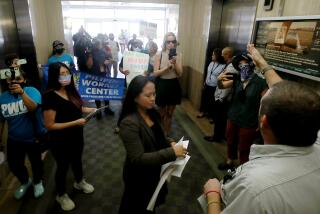Californians need higher wages and better jobs, Newsom commission says

California’s high poverty rate, low wages and frayed public safety net require a new “social compact” between workers, business and government, according to a report by a blue-ribbon commission that highlights the state’s widening inequality.
In a report released Tuesday, the Future of Work Commission, a 21-member body appointed by Gov. Gavin Newsom in August 2019, laid out a grim picture of the challenges facing the world’s fifth-largest economy, even as it acknowledged the Golden State’s technology leadership, its ethnically and culturally diverse workforce and world-class universities.
“Too many Californians have not fully participated in or enjoyed the benefits of the state’s broader economic success and the extraordinary wealth generated here, especially workers of color who are disproportionately represented in low-wage industries,” the report says.
California has the highest poverty rate in the country when accounting for the cost of living, 17.2%, according to the report. Since 2012, wages in the state grew by 14% while home prices rose by 68%.
Half of California’s spending on public assistance programs such as Medicaid and Temporary Assistance to Needy Families goes to recipients in working families. Working people of color are over three times more likely than white workers to live in poverty.
And the COVID-19 pandemic has highlighted the challenges: Among California’s low-wage workers, 53% are employed in essential occupations, which are most vulnerable to the virus, compared with 39% of workers in middle- and high-wage occupations, many of whom are able to work from home, according to the report.
Much of December’s distress was driven by hotels and restaurants closing, as tourism and business travel failed to bounce back and dining out was restricted.
The report says less than half of California workers are in “quality jobs,” which it defines as “providing a living wage, stable and predictable pay, control over scheduling, access to benefits, a safe and dignified work environment, and opportunities for training and career advancement.”
The commission called for “bold, measurable moon-shot goals” by 2030 to tackle the state’s myriad challenges. It was co-chaired by James Manyika, director of McKinsey Global Institute, the McKinsey & Co. consulting firm’s research arm, and Mary Kay Henry, president of the Service Employees International Union, California’s largest labor group. It included government officials, business executives, civic leaders and academics and sets out an ambitious agenda for the next decade.
Among the recommendations:
- Guarantee the creation of enough jobs for all Californians who want to work.
- Eliminate poverty among working Californians by raising wages.
- Double the share of California workers who have access to employment-tied benefits.
- Create a “California Job Quality Index” and steer state procurement to companies that create high-quality jobs.
- “Rebalance power” with employers through worker organizations and unions.
“It’s a call to action,” said Julie Su, secretary of California’s Labor and Workforce Development Agency, who was nominated last month to be deputy secretary of Labor in the Biden administration.
Employers enter 2021 facing new obligations to report coronavirus outbreaks, diversify their boards of directors and provide more family leave, among other things.
Unlike similar reports published by nonprofit and business groups in recent years, the California report does not mainly focus on commonly cited forces of economic disruption, including automation and skills gaps, she said.
“It takes a different tack: It’s about improving the quality of jobs. And what has to happen is that workers need more power in the workplace.”
Over 18 months, the commission met 11 times in six cities but went virtual when the pandemic hit. It heard testimony from 42 workers, business leaders, academics, public officials and community activists, invited public comments, and pored over 36 studies and other documents. All meeting videos and documents are posted on its website.
The diversity of commission members was “unusual,” said Manyika, whose McKinsey group has published four major Future of Work reports. “With other efforts, you have mostly like-minded people. It was a remarkable achievement to agree on these goals.”
In the face of the state’s economic crisis — unemployment in December stood at 9% — the state and federal governments can act as “a backstop to guarantee all Californians a job through incentives for private sector job creation or public employment,” the report said.
At least 1 million jobs could be created in clean energy technologies, residential solar and electric cars, it added, furthering Newsom’s initiatives to combat climate change.
One way to raise wages, the report suggests, would be to create regional wage floors using MIT’s widely accepted living wage calculator that factors in cost of living. Workers in the low-paid hospitality, retail and care sectors could benefit first.
The report argues union representation is significant in reducing low-wage employment. The share of California workers who are unionized has declined from 24% in 1980 to 16.5% in 2019.
Although most labor law is federally determined, “the commission calls for rewriting the rules to make sure all working people are free to join together in unions,” said Henry, the SEIU leader.
“There’s tremendous employer resistance to unions,” she said. “But we have a commission agreeing that a key lever on racial and economic inequality is the ability of workers to collectively bargain. We’ve not had a chorus of voices on that point before. It’s a big shift.”
Businesses and economists cite the need for higher education to raise wages, but the report also says, “While the probability of low-wage employment is reduced by 33% if a worker has a college degree, it is reduced by 39% if a worker is a member of a union.”
The report singles out the care sector, whose workers have been on the front lines during the pandemic, as particularly in need of higher wages. State employment data project “personal care aides” as the largest growth sector from 2018 to 2028, with 1.1 million job openings, followed by cashiers, laborers and restaurant servers — all low-wage jobs.
And it calls for stricter enforcement of wage theft, overtime and workplace safety laws. “Existing employment and labor laws are not well enforced,” it says, citing “complex schemes by employers designed to cover up violations, lack of trust in government, and inadequate resources.”
Some of the report’s goals lack specifics: There is no call in the benefits section to boost California’s three days of mandatory sick leave, and no endorsement of a ban on last-minute shift scheduling for retail workers.
Manyika said this was deliberate because the commission, which met in public, was not set up to hammer out legislative proposals.
Some significant issues affecting the workforce were only touched upon lightly, including the rapidly expanding gig economy.
“The availability of ‘good jobs’ is threatened by practices such as subcontracting, including through multiple levels of middlemen, and misclassification of workers as independent contractors,” the report says.
The debate over classifying workers as independent contractors rather than employees with benefits and minimum wage protections has been the most salient California labor issue of the last two years. Uber, Lyft, DoorDash and other companies poured more than $200 million into a successful November ballot initiative to exempt their drivers from being classified as employees.
“The idea of a social compact for jobs is promising, but it presupposes that big business and technology companies will agree to be bound by it,” said Madeline Janis, executive director of Jobs to Move America, a worker advocacy nonprofit. Janis said the report fails to lay out enforcement proposals for California businesses.
The $1.2-million cost of the commission’s work was funded by $700,000 from the James Irvine Foundation, $250,000 from Blue Shield of California Foundation; $200,000 from the Ford Foundation and $100,000 from Lumina Foundation.
More to Read
Inside the business of entertainment
The Wide Shot brings you news, analysis and insights on everything from streaming wars to production — and what it all means for the future.
You may occasionally receive promotional content from the Los Angeles Times.













